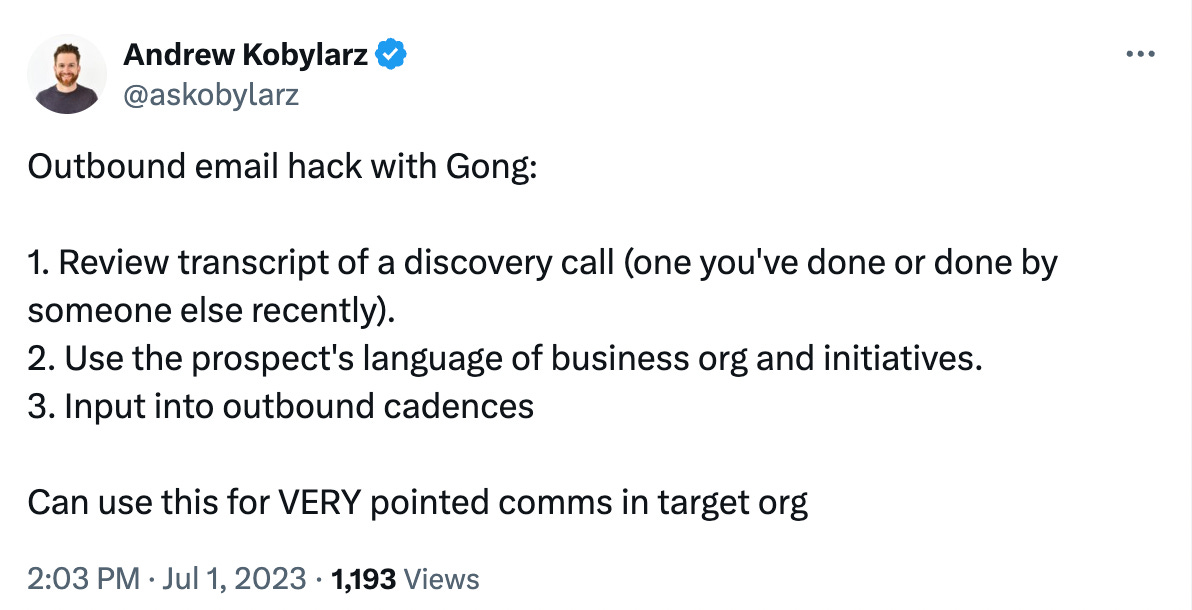Data to Dialogue: 3 Perspectives on Human Insight
Bridging technology with human touch
Buyers are more inundated than ever today. Ironically, technology is amplifying this.
Last week we walked through how to build custom GPTs so that you can tailor your outreach (also ironic, ha). It probably comes as no surprise that I’m a big proponent of augmenting rather than replacing.
Once you get the meeting, it’s no longer about your tech stack. This is where the actual money is made. Here’s a glimpse at what sellers are facing today:
I’ve been having conversations with different business units and teams within my accounts over the past few weeks. All of the above hit home. What’s more interesting is observing how people react when you combine the human element backed by your tech stack.
Today will be a mix of tactics and strategies that bridge how I’m using AI in my day to day with the actual customer facing scenarios that everyone as a seller experiences selling to any business.
Use Your Historical Data
Slow down to speed up
Multi Threading
Use Your Historical Data
Nothing worse than coming into a call and asking a lazy question to prospect. It telegraphs you don’t care. Oddly enough, even if you don’t have it right, just showing that you put in the effort goes a long way.
Your CRM, Gong, and any other historical data sets are your best friends.
USE THEM.
I find Gong is the easiest way to extract easy to understand for a customer’s business outcomes. It helps with two things:
Let’s you use your customer’s language
Dumbs down “business jargon” into “simple speak”
If you have the high level “why” then you can modify to the level of the persona you’re speaking with. Start connecting the dots to build your own thesis that is aligned with the overarching objectives. This will empower you to multithread (more on this below).
A few other reasons why you should be using your historical data:
Everyone’s time is limited. No one likes repeating themselves. Summarize what you know and confirm. Ask what has changed, if anything, to keep the discussion relevant.
It’s amazing how productive discovery calls can be in a limited time if you come prepared with pointed questions and a summary of what you understand.
Slow Down to Speed Up
Everyone wants “fast” and “now”. It’s hard to to say “no” to quick money but you’ll thank yourself when you get the “yes” for the big money.
Slowing down to speed up was one of my previous sales leader’s favorite tactics. It allows you to build more value, understand the problem better, and qualify.
More importantly, it gives your buyer a better experience. Better to do something “right” when you’re selling to a business. Process is everything.
There is advice about not being “perfect” and just “get it done”. Nothing ever is perfect. But it’s important to note who you’re selling to - a person who wants to keep their job. You remove risk for the both of you by simply saying let’s slow this down.
Multi Threading
When you take the time to do your research or slow down a fast moving project, you inevitably discover more and more. This positions you to be a valuable conduit for the business.
I’ve written previously about this but the more I’m in the field the more this resonates. A lot of this has to do with buyer journey and their experience within the sales cycle.
“The sobering truth about most companies is that people don't talk to each other. Teams are siloed by function, geography, and level. Employees become preoccupied with local concerns and lose touch with adjacent realities. Executives find themselves increasingly dissociated from the day-to-day ordeals on the front lines, especially in a hybrid environment.”
-Douglas Cole
Credit: Douglas Cole, Distillations
Ultimately, the seller (you), gain more perspective about your customer’s business that:
Executives don’t have visibility into.
Employees don’t have time to think about in their day to day
Provides a unique and outside perspective that your customer might not ever see.
The last point is the most important.
If you’re selling to a certain persona, think about the number of companies they’ve worked at in their career. Now compare this to the number of conversations you have with that same persona, at multiple companies, over the course of a YEAR.
It’s invaluable. Even more powerful when you layer the context of what you understand about a customer’s business and your version of a hypothesis to obtain the desired outcome.
All this ties together because this is the element of being human. It’s leveraging data and tech to craft simple, understandable narratives that relate to all levels at a company. We’re all human at the end of the day.
Simple Applications
Although these are tactics I’ve been using for some time, Jason Bay summarized this nicely in a recent podcast with John Barrows on the Make It Happen Monday Podcast.
On Slowing down:
“Glad you’re excited about this but here’s a thought/concern on why we should proceed in xyz way”
On Multi-threading:
“Just keeping you in the loop and can provide updates on how things progress. No response necessary”.
The communication style isn’t fancy, technical, or verbose.
It’s simple. Human.
Check out the podcast if you have the time, well worth the listen.
If you have questions about these tactics or formulating them, shoot a DM to askobylarz on X or an email to andrew@hackingsales.xyz.
As always, thank you for reading and see you all next week.
-Andrew K



